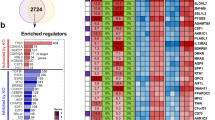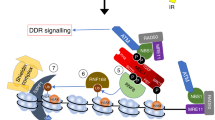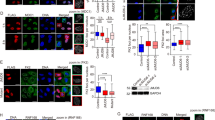Abstract
Homeodomain-interacting protein kinase 2 (HIPK2) is a potential tumor suppressor that has a crucial role in the DNA damage response (DDR) by regulating cell-cycle checkpoint activation and apoptosis. However, it is unclear whether HIPK2 exerts distinct roles in DNA damage repair. The aim of this study was to identify novel target molecule(s) of HIPK2, which mediates HIPK2-dependent DNA damage repair. HIPK2-knockdown human colon cancer cells (HCT116) or hipk1/hipk2 double-deficient mouse embryonic fibroblasts could not remove histone H2A.X phosphorylated at Ser139 (γH2A.X) after irradiation with a sublethal dose (10 J/m2) of ultraviolet (UV)-C, resulting in apoptosis. Knockdown of HIPK2 in p53-null HCT116 cells similarly promoted the UV-C-induced γH2A.X accumulation and apoptosis. Proteomic analysis of HIPK2-associated proteins using liquid chromatography-tandem mass spectrometry identified heterochromatin protein 1γ (HP1γ) as a novel target for HIPK2. Immunoprecipitation experiments with HCT116 cells expressing FLAG-tagged HIPK2 and one of the HA-tagged HP1 family members demonstrated that HIPK2 specifically associated with HP1γ, but not with HP1α or HP1β, through its chromo-shadow domain. Mutation of the HP1box motif (883-PTVSV-887) within HIPK2 abolished the association. HP1γ knockdown also enhanced accumulation of γH2A.X and apoptosis after sublethal UV-C irradiation. In vitro kinase assay demonstrated an HP1γ-phosphorylating activity of HIPK2. Sublethal UV-C irradiation phosphorylated HP1γ. This phosphorylation was absent in endogenous HIPK2-silenced cells with HIPK2 3’UTR siRNA. Overexpression of FLAG-HIPK2, but not the HP1box-mutated or kinase-dead HIPK2 mutant, in the HIPK2-silenced cells increased HP1γ binding to trimethylated (Lys9) histone H3 (H3K9me3), rescued the UV-C-induced phosphorylation of HP1γ, triggered release of HP1γ from histone H3K9me3 and suppressed γH2A.X accumulation. Our results suggest that HIPK2-dependent phosphorylation of HP1γ may participate in the regulation of dynamic interaction between HP1γ and histone H3K9me3 to promote DNA damage repair. This HIPK2/HP1γ pathway may uncover a new functional aspect of HIPK2 as a tumor suppressor.
This is a preview of subscription content, access via your institution
Access options
Subscribe to this journal
Receive 50 print issues and online access
$259.00 per year
only $5.18 per issue
Buy this article
- Purchase on Springer Link
- Instant access to full article PDF
Prices may be subject to local taxes which are calculated during checkout






Similar content being viewed by others
References
Soria G, Polo SE, Almouzni G . Prime, repair, restore: the active role of chromatin in the DNA damage response. Mol Cell 2012; 46: 722–734.
Sombroek D, Hofmann TG . How cells switch HIPK2 on and off. Cell Death Differ 2009; 16: 187–194.
Puca R, Nardinocchi L, Givol D, D'Orazi G . Regulation of p53 activity by HIPK2: molecular mechanisms and therapeutical implications in human cancer cells. Oncogene 2010; 29: 4378–4387.
Winter M, Sombroek D, Dauth I, Moehlenbrink J, Scheuermann K, Crone J et al. Control of HIPK2 stability by ubiquitin ligase Siah-1 and checkpoint kinases ATM and ATR. Nat Cell Biol 2008; 10: 812–824.
Gresko E, Roscic A, Ritterhoff S, Vichalkovski A, del Sal G, Schmitz ML . Autoregulatory control of the p53 response by caspase-mediated processing of HIPK2. EMBO J 2006; 25: 1883–1894.
Saul VV, de la Vega L, Milanovic M, Kruger M, Braun T, Fritz-Wolf K et al. HIPK2 kinase activity depends on cis-autophosphorylation of its activation loop. J Mol Cell Biol 2013; 5: 27–38.
D'Orazi G, Cecchinelli B, Bruno T, Manni I, Higashimoto Y, Saito S et al. Homeodomain-interacting protein kinase-2 phosphorylates p53 at Ser46 and mediates apoptosis. Nat Cell Biol 2002; 4: 11–19.
Hofmann TG, Moller A, Sirma H, Zentgraf H, Taya Y, Droge W et al. Regulation of p53 activity by its interaction with homeodomain-interacting protein kinase-2. Nat Cell Biol 2002; 4: 1–10.
Hofmann TG, Glas C, Bitomsky N . HIPK2: a tumour suppressor that controls DNA damage-induced cell fate and cytokinesis. Bioessays 2013; 35: 55–64.
Di Stefano V, Soddu S, Sacchi A, D'Orazi G . HIPK2 contributes to PCAF-mediated p53 acetylation and selective transactivation of p21Waf1 after nonapoptotic DNA damage. Oncogene 2005; 24: 5431–5442.
Papamichos-Chronakis M, Peterson CL . Chromatin and the genome integrity network. Nat Rev Genet 2013; 14: 62–75.
Price BD, D'Andrea AD . Chromatin remodeling at DNA double-strand breaks. Cell 2013; 152: 1344–1354.
Kwon SH, Workman JL . The heterochromatin protein 1 (HP1) family: put away a bias toward HP1. Mol Cells 2008; 26: 217–227.
Lomberk G, Wallrath L, Urrutia R . The heterochromatin protein 1 family. Genome Biol 2006; 7: 228.
Nielsen AL, Oulad-Abdelghani M, Ortiz JA, Remboutsika E, Chambon P, Losson R . Heterochromatin formation in mammalian cells: interaction between histones and HP1 proteins. Mol Cell 2001; 7: 729–739.
Kwon SH, Workman JL . The changing faces of HP1: From heterochromatin formation and gene silencing to euchromatic gene expression: HP1 acts as a positive regulator of transcription. Bioessays 2011; 33: 280–289.
Ayoub N, Jeyasekharan AD, Bernal JA, Venkitaraman AR . HP1-beta mobilization promotes chromatin changes that initiate the DNA damage response. Nature 2008; 453: 682–686.
Lee YH, Kuo CY, Stark JM, Shih HM, Ann DK . HP1 promotes tumor suppressor BRCA1 functions during the DNA damage response. Nucleic Acids Res 2013; 41: 5784–5798.
Luijsterburg MS, Dinant C, Lans H, Stap J, Wiernasz E, Lagerwerf S et al. Heterochromatin protein 1 is recruited to various types of DNA damage. J Cell Biol 2009; 185: 577–586.
Zarebski M, Wiernasz E, Dobrucki JW . Recruitment of heterochromatin protein 1 to DNA repair sites. Cytometry A 2009; 75: 619–625.
Kurokawa K, Akaike Y, Masuda K, Kuwano Y, Nishida K, Yamagishi N et al. Downregulation of serine/arginine-rich splicing factor 3 induces G1 cell cycle arrest and apoptosis in colon cancer cells. Oncogene 2014; 33: 1407–1417.
Hailemariam K, Iwasaki K, Huang BW, Sakamoto K, Tsuji Y . Transcriptional regulation of ferritin and antioxidant genes by HIPK2 under genotoxic stress. J Cell Sci 2010; 123: 3863–3871.
Rastogi RP, Richa, Kumar A, Tyagi MB, Sinha RP . Molecular mechanisms of ultraviolet radiation-induced DNA damage and repair. J Nucleic Acids 2010; 2010: 592980.
Lee DH, Chowdhury D . What goes on must come off: phosphatases gate-crash the DNA damage response. Trends Biochem Sci 2011; 36: 569–577.
Mah LJ, El-Osta A, Karagiannis TC . gammaH2AX: a sensitive molecular marker of DNA damage and repair. Leukemia 2010; 24: 679–686.
Lobrich M, Shibata A, Beucher A, Fisher A, Ensminger M, Goodarzi AA et al. gammaH2AX foci analysis for monitoring DNA double-strand break repair: strengths, limitations and optimization. Cell Cycle 2010; 9: 662–669.
Kim YH, Choi CY, Lee SJ, Conti MA, Kim Y . Homeodomain-interacting protein kinases, a novel family of co-repressors for homeodomain transcription factors. J Biol Chem 1998; 273: 25875–25879.
Isono K, Nemoto K, Li Y, Takada Y, Suzuki R, Katsuki M et al. Overlapping roles for homeodomain-interacting protein kinases hipk1 and hipk2 in the mediation of cell growth in response to morphogenetic and genotoxic signals. Mol Cell Biol 2006; 26: 2758–2771.
Rinaldo C, Prodosmo A, Siepi F, Soddu S . HIPK2: a multitalented partner for transcription factors in DNA damage response and development. Biochem Cell Biol 2007; 85: 411–418.
Smothers JF, Henikoff S . The HP1 chromo shadow domain binds a consensus peptide pentamer. Curr Biol 2000; 10: 27–30.
LeRoy G, Weston JT, Zee BM, Young NL, Plazas-Mayorca MD, Garcia BA . Heterochromatin protein 1 is extensively decorated with histone code-like post-translational modifications. Mol Cell Proteomics 2009; 8: 2432–2442.
Yamada D, Perez-Torrado R, Filion G, Caly M, Jammart B, Devignot V et al. The human protein kinase HIPK2 phosphorylates and downregulates the methyl-binding transcription factor ZBTB4. Oncogene 2009; 28: 2535–2544.
Wei G, Ku S, Ma GK, Saito S, Tang AA, Zhang J et al. HIPK2 represses beta-catenin-mediated transcription, epidermal stem cell expansion, and skin tumorigenesis. Proc Natl Acad Sci USA 2007; 104: 13040–13045.
Rinaldo C, Moncada A, Gradi A, Ciuffini L, D'Eliseo D, Siepi F et al. HIPK2 controls cytokinesis and prevents tetraploidization by phosphorylating histone H2B at the midbody. Mol Cell 2012; 47: 87–98.
Lomberk G, Bensi D, Fernandez-Zapico ME, Urrutia R . Evidence for the existence of an HP1-mediated subcode within the histone code. Nat Cell Biol 2006; 8: 407–415.
Grzenda A, Leonard P, Seo S, Mathison AJ, Urrutia G, Calvo E et al. Functional impact of Aurora A-mediated phosphorylation of HP1γ at serine 83 during cell cycle progression. Epigenetics Chromatin 2013; 6: 21.
Zhang Q, Yoshimatsu Y, Hildebrand J, Frisch SM, Goodman RH . Homeodomain interacting protein kinase 2 promotes apoptosis by downregulating the transcriptional corepressor CtBP. Cell 2003; 115: 177–186.
Nardinocchi L, Puca R, Sacchi A, D'Orazi G . HIPK2 knock-down compromises tumor cell efficiency to repair damaged DNA. Biochem Biophys Res Commun 2007; 361: 249–255.
Pontarin G, Ferraro P, Bee L, Reichard P, Bianchi V . Mammalian ribonucleotide reductase subunit p53R2 is required for mitochondrial DNA replication and DNA repair in quiescent cells. Proc Natl Acad Sci USA 2012; 109: 13302–13307.
Yamaguchi T, Matsuda K, Sagiya Y, Iwadate M, Fujino MA, Nakamura Y et al. p53R2-dependent pathway for DNA synthesis in a p53-regulated cell cycle checkpoint. Cancer Res 2001; 61: 8256–8262.
Choi DW, Na W, Kabir MH, Yi E, Kwon S, Yeom J et al. WIP1, a homeostatic regulator of the DNA damage response, is targeted by HIPK2 for phosphorylation and degradation. Mol Cell 2013; 51: 374–385.
Baldeyron C, Soria G, Roche D, Cook AJ, Almouzni G . HP1alpha recruitment to DNA damage by p150CAF-1 promotes homologous recombination repair. J Cell Biol 2011; 193: 81–95.
Dinant C, Luijsterburg MS . The emerging role of HP1 in the DNA damage response. Mol Cell Biol 2009; 29: 6335–6340.
Minc E, Courvalin JC, Buendia B . HP1gamma associates with euchromatin and heterochromatin in mammalian nuclei and chromosomes. Cytogenet Cell Genet 2000; 90: 279–284.
Goodarzi AA, Noon AT, Deckbar D, Ziv Y, Shiloh Y, Lobrich M et al. ATM signaling facilitates repair of DNA double-strand breaks associated with heterochromatin. Mol Cell 2008; 31: 167–177.
Kim JA, Kruhlak M, Dotiwala F, Nussenzweig A, Haber JE . Heterochromatin is refractory to gamma-H2AX modification in yeast and mammals. J Cell Biol 2007; 178: 209–218.
Noon AT, Shibata A, Rief N, Lobrich M, Stewart GS, Jeggo PA et al. 53BP1-dependent robust localized KAP-1 phosphorylation is essential for heterochromatic DNA double-strand break repair. Nat Cell Biol 2010; 12: 177–184.
Chiolo I, Minoda A, Colmenares SU, Polyzos A, Costes SV, Karpen GH . Double-strand breaks in heterochromatin move outside of a dynamic HP1a domain to complete recombinational repair. Cell 2011; 144: 732–744.
Jakob B, Splinter J, Conrad S, Voss KO, Zink D, Durante M et al. DNA double-strand breaks in heterochromatin elicit fast repair protein recruitment, histone H2AX phosphorylation and relocation to euchromatin. Nucleic Acids Res 2011; 39: 6489–6499.
Cann KL, Dellaire G . Heterochromatin and the DNA damage response: the need to relax. Biochem Cell Biol 2011; 89: 45–60.
Hiragami-Hamada K, Shinmyozu K, Hamada D, Tatsu Y, Uegaki K, Fujiwara S et al. N-terminal phosphorylation of HP1{alpha} promotes its chromatin binding. Mol Cell Biol 2011; 31: 1186–1200.
Kuwano Y, Pullmann R Jr., Marasa BS, Abdelmohsen K, Lee EK, Yang X et al. NF90 selectively represses the translation of target mRNAs bearing an AU-rich signature motif. Nucleic Acids Res 2010; 38: 225–238.
Mund A, Schubert T, Staege H, Kinkley S, Reumann K, Kriegs M et al. SPOC1 modulates DNA repair by regulating key determinants of chromatin compaction and DNA damage response. Nucleic Acids Res 2012; 40: 11363–11379.
Acknowledgements
This work was supported by JSPS KAKENHI Grant Number 24-8354 (to YA).
Author information
Authors and Affiliations
Corresponding author
Ethics declarations
Competing interests
The authors declare no conflict of interest.
Additional information
Supplementary Information accompanies this paper on the Oncogene website
Supplementary information
Rights and permissions
About this article
Cite this article
Akaike, Y., Kuwano, Y., Nishida, K. et al. Homeodomain-interacting protein kinase 2 regulates DNA damage response through interacting with heterochromatin protein 1γ. Oncogene 34, 3463–3473 (2015). https://doi.org/10.1038/onc.2014.278
Received:
Revised:
Accepted:
Published:
Issue Date:
DOI: https://doi.org/10.1038/onc.2014.278
This article is cited by
-
CBX3 accelerates the malignant progression of glioblastoma multiforme by stabilizing EGFR expression
Oncogene (2022)
-
Overexpression of homeodomain-interacting protein kinase 2 (HIPK2) attenuates sepsis-mediated liver injury by restoring autophagy
Cell Death & Disease (2018)
-
Crosstalk between NRF2 and HIPK2 shapes cytoprotective responses
Oncogene (2017)



